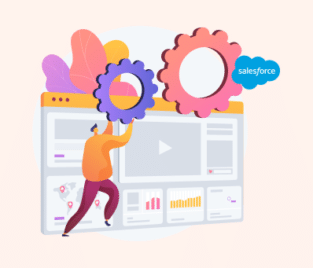Salesforce Experience Cloud for Healthcare | Complete Knowledge Base
Salesforce Experience Cloud allows healthcare professionals build custom online communities and portals branded to their unique web project requirements. When organizations create these types of projects, they provide seamless and connected content across all communication channels, which patients learn to trust. Web portals created with Salesforce Experience Cloud ensure that everyone interacting with your brand can engage in seamless self-service and access relevant resources from anywhere in the world.
So, if you are looking to extend your digital experiences with portals or web projects that have self-service, 24/7 support, knowledge bases, and other patient engagement options, follow our guide as we explore Experience Cloud and the leading alternatives to Salesforce Experience Cloud in the market.

What is Experience Cloud in Salesforce for Healthcare?
It’s a cloud-based customer experience platform, previously known as Salesforce Community Cloud. Experience Cloud might have started with a different name in 2014, but it still helps healthcare organizations with practice management, empowering them to create secure online portals and communities for their patients to this day.
You can securely display and share all the content you want about your medical products and services to patients, employees, and even partners with Experience Cloud at your disposal. There are many reasons why you might want to take this approach and a common one for many practices is that articles, guides, and forums hosted on portals help patients troubleshoot any product or service issues that arise immediately and independently.
Since Experience Cloud is a premium Salesforce product, you can also trust that it integrates exceptionally well with your CRM platform to enjoy all your usual Salesforce benefits.
Explaining the difference between Experience Cloud and Salesforce Site for Healthcare Admins
If you need web projects that do not require patients to log into a portal with a username and password to access content, then you need a Salesforce Site.
With a Salesforce Site, healthcare admins can build public websites or web apps for any visitor to access without a username or password. As a Salesforce Site is a product of Salesforce, you can trust that it integrates well with your CRM platform and the other products provided in the system.
Many healthcare organizations use Salesforce Site to create branded websites that display content they want to share with the public.
Salesforce Community Cloud Limitations in Healthcare
Before it became Experience Cloud, this product was known as Salesforce Community Cloud. Salesforce Community enabled healthcare organizations to create online communities for their products. While this has been a great way for practices to offer personalized recommendations, resolve cases, collaborate with their community, and offer branded experiences, this product was still limited.
The biggest limitation was that it didn’t encompass the full range of digital capabilities, namely empowering healthcare organizations to build web apps and portals.
To overcome some of these issues, Community Cloud was rebranded as Experience Cloud in the Spring ’21 Salesforce Release.

Features of Salesforce Experience Cloud Relevant to Healthcare
Let’s check out some of the most powerful features of the Experience Cloud product for healthcare organizations:
Experience Cloud Pricing for Healthcare Managers
While Experience Cloud is an innovative product, it does come with a considerable price tag:
Self-service:
- Customer Community starts at $2 per login or $5 per member.
- Customer Community Plus starts at $6 per login or $15 per member.
Partner Relationship Management:
- This package starts at $10 per login or $25 per member.
External Apps:
- This edition starts at $15 per login or $35 per member.
Salesforce Content Management System:
This package is included in Experience Cloud purchases. However, quotes are customized and you will need to reach out to Salesforce directly for more pricing information.
As you can see, the cost of Experience Cloud can add up quickly for healthcare practices depending on how many logins or members they need for a portal. Before purchasing this product, make sure you have the budget to scale up. For example, if you need 300 members of Customer Community Plus, this will cost you $4500.
If you are a larger healthcare network, this will nowhere near cover the number of members you need. Try imagining paying $30,000 for 2000 members of the same portal. This is a serious expense.
Salesforce Experience Cloud Examples and Healthcare Use Cases
Now that we know the limitations and features of Experience Cloud, it’s time to kick off with some use cases for the healthcare industry. Whether you work at a business-to-consumer (B2C) or a business-to-business (B2B) healthcare organization, many use cases can be explored to see how Experience Cloud can be maximized to improve customer or patient experiences and interactions.
Patient Portals
Many healthcare organizations create patient portals with Experience Cloud so their members can access medical records, schedule appointments with doctors, or chat with consultants. These patient engagement portals empower users to access self-service options 24/7, like payment options conveniently, and assist with streamlined Electronic Health Records (EHR) management.
Member Portals
Member portals for healthcare can be created with Customer Community in Salesforce. A Salesforce member portal is a solid choice if your healthcare organization wants to provide members with self-service options. For example, uploaded articles give members insight into products and services, a support center empowers members to log tickets to healthcare providers, and various other patient record management features that allow them to edit their details, make purchases, and track orders.
Provider Portals
Numerous healthcare practices collaborate on joint projects to reach more patients and increase revenue. Creating a Salesforce provider or payer portal is super beneficial to successfully transfer information and keep all parties up to date. A provider portal with Salesforce data allows your healthcare professionals, insurance companies, and other partners to collaborate seamlessly on ventures and instantly share information related to patient details, claims, and referrals.
The ability to have access to the latest Salesforce data at all times supports medical practitioners with helping more patients faster while resolving any queries that might pop up in the service provided.
Healthcare Employee Portals
Healthcare providers can also use Experience Cloud coupled with Salesforce to build internal projects such as an employee portal. An employee portal is an excellent tool for coworkers to access and update their details independently when they change. You could also supply payroll information on the employee portal to make it easier for colleagues to track and print out pay slips.
A considerable number of healthcare organizations use employee portals to track leave and ask their team members to submit requests through the system. More than just the basics, though, you could revamp your employee portal by displaying medical documents and adding a Salesforce collaboration group for coworkers to engage and participate in training programs.
Salesforce Healthcare Knowledge Management System
A Healthcare Knowledge Management System (KMS) is an excellent space to upload any clinical guidelines, policies, or patient FAQs related to the products and services of your practice.
Healthcare organizations often upload articles, tutorials, how-to guides, and troubleshooting content to their Salesforce Healthcare KMS. Patients and employees can then easily access these resources to learn more about a treatment or use them to resolve issues independently.
Salesforce Event and Training Management for Healthcare
Experience Cloud can be used to create portals for Salesforce event management. Adding medical groups to a portal with Salesforce for event management helps event organizers create healthcare digital transformations that include registering medical professionals, creating schedules, tracking certifications, or managing communication channels that discuss guest requirements for regulatory compliance in healthcare training sessions, medical conferences, and other types of events.
Salesforce Feedback and Ideas Exchange
Healthcare networks that need feedback from employees, patients, or partners will find creating a feedback and ideas exchange portal quite valuable. The portal can be built using patient feedback software (like Experience Cloud) and then used to upload surveys. Users logged into the feedback and ideas exchange portal can fill out the surveys with their opinions and submit them back to the healthcare organization.
You could also add a group to the Salesforce idea exchange and feedback portal to gather innovative ideas from colleagues and partners so logged-in users can join and share thoughts on medical-related topics.
Salesforce Case Management
A case management portal can be created with medical record automation in mind and a Salesforce Health Cloud integration with Experience Cloud. Your medical teams would be able to track patient concerns, referrals, and care coordination that are logged from the case management portal directly in Salesforce.
Additionally, managers can monitor the resolution times of patient disputes through the case management portal. These metrics can then be analyzed to improve case management and Salesforce strategies.
Patient Onboarding
Healthcare organizations that want their new patients or employees to have positive experiences focus on Salesforce onboarding strategies. One master plan to start with automated patient intake in Salesforce is to create a portal that streamlines all the processes during enrollment, such as registering patients to systems or allowing them to submit documents online.
Another common plan is to create a portal to assist with physician onboarding in the healthcare setting.
Sales Experience Cloud: Sales Enablement in Healthcare
A Salesforce sales enablement portal serves medical device companies and pharmaceutical reps the most. It can help by providing a digital space to host resources, tools, or any information that can help medical reps interact with healthcare providers and patients. These resources are vital since they can be referenced anytime during the sales process.
A portal for sales enablement in Salesforce can also help as a central location for training, onboarding, and certifications for your medical reps. And these resources don’t have to be uploaded as documents. With Salesforce Experience Cloud, you can upload quizzes and training videos to engage your medical reps in the latest selling skills.
Salesforce E-commerce Integration in Healthcare
To make the most out of your data, you could link a Salesforce e-commerce integration to your patient portal.
A patient portal designed for the e-commerce sector can allow logged-in users to track their purchased orders, manage returned orders, access their purchase histories, and manage their data like billing addresses and credit card details.
Creating an e-commerce integration with Salesforce from your patient portal will ensure that all edits from patients are pushed to Salesforce automatically to eliminate any manual data entry for your employees.
For more information about Salesforce’s specific industry cloud for healthcare providers, please refer to our Salesforce Health Cloud guide.
Salesforce: Patient Experience Platform Alternatives
As outstanding as Experience Cloud is at providing you with cloud-based healthcare solutions that meet patient expectations for the latest and most current content that is available 24/7, it is not the only platform that exists to offer you these benefits.
We earlier discussed the limitations of Experience Cloud as a patient experience portal solution, and these may resonate with you.
If you are interested in finding out about other reliable platforms on the market that can help you engage with your patients while integrating with Salesforce data, join us below.
Wix
First on the list is Wix. It’s a popular cloud-based platform focused on developing websites. Wix customers use the platform to create and manage websites without coding knowledge. Are they captivating enough for your healthcare requirements? Let’s take an objective look at their pros and cons.
Pros
Cons
Skuid
Next on the list is the software platform Skuid. Healthcare organizations can employ Skuid to design and launch custom user interfaces for data-driven applications. Do they have unique Salesforce solutions for your patient experiences? Let’s dive into their pros and cons.
Pros
Cons
WordPress
WordPress, an open-source content management system (CMS) platform, was used to build over 800 million websites. Released in 2003, it has been a popular tool for designing and managing websites. WordPress provides a platform that is accessible to everyone from bloggers to large healthcare networks, but do they have custom solutions that meet your specific Salesforce requirements?
Let’s take a look at its pros and cons:
Pros
Cons
Adobe Experience Manager
If you opt for a CMS platform like Adobe Experience Manager, you get to create and manage your digital experiences for various distribution channels. This platform is used by many healthcare organizations to deliver their products and services via web, mobile, email, and social media platforms. There are many perks to choosing Adobe Experience Manager, but are they the right Salesforce solution for your practice?
Let’s dive into the pros and cons of an Adobe Experience Manager Salesforce integration:
Pros
Cons
Jitterbit
Jitterbit provides software solutions for integrations and API management. Founded in 2003, Jitterbit is used by many healthcare organizations to connect different applications and data sources found in their work systems. Before you give Jitterbit and Salesforce a chance, let’s take a look at its pros and cons:
Pros
Cons
Sitecore Experience Platform
Sitecore is another CMS platform on our list that healthcare professionals could use to create digital experiences. Sitecore is popular amongst healthcare organizations that need to manage websites, mobile applications, or e-commerce platforms across various channels. Is a Sitecore Salesforce integration your best option?
Let’s explore the pros and cons of this duo:
Pros
Cons
Magentrix
Many healthcare organizations choose Magentrix as their partner relationship management and patient experience management software in Salesforce. If you need a solution to manage relationships with resellers, distributors, vendors, or patients, then Magentrix is a solid cloud-based software platform, but are they the best option for your Salesforce needs?
Let’s take a look at its pros and cons:
Pros
Cons
Since we brought up data structures, it is a good time to mention our Data Model for Health Cloud article. Make sure to check it out for a better understanding on how to manage Personal Health Information (PHI) safely and securely.
Titan Web
Titan Web is a no-code platform that supercharges your patient experiences in Salesforce. Healthcare teams use Titan Web to create and launch no-code websites, portals, surveys, and other projects. Titan is the only product on the market that integrates bi-directionally with Salesforce using zero code to guarantee that all data is in sync with your projects and healthcare CRM solutions in real-time.
Titan Web has intuitive drag-and-drop tools that give healthcare teams a single solution to optimize all tasks, whether building a digital patient registration workflow that moves files to Salesforce or styling a survey for employee feedback!
It’s no wonder this powerful platform has a 4.96 out of 5-star rating from trailblazers on the Salesforce AppExchange marketplace.
Titan Web integrates natively with Salesforce Experience Cloud to bring you to patients faster than before. OR use it as an alternative to build branded portals and web apps in healthcare without an Experience Cloud license. Another advantage is that Titan Web does not charge per member or login, instead you pay a flat rate when you buy the product!
Nowadays, no one wants to stand in a long line at a clinic to check in for a doctor’s visit or waste their day physically traveling to collect test results. By leveraging Titan Web, you can build seamless Salesforce healthcare optimization experiences for your patients, enabling them to engage in a range of self-service options from anywhere in the world.
For a more in-depth look at what you get from Titan Web, check out these pros and cons:
Pros
Cons
Wrapping Up Salesforce Experience Cloud for Healthcare
Thank you for taking the time to stop by and read our guide on Salesforce Experience Cloud in healthcare. We understand how important it is to know all the benefits and limitations that your healthcare compliance software contains so that you can choose the best Salesforce solution for your needs. We have also provided a comprehensive list of the most reliable software on the market to help you elevate your patient experiences in Salesforce.
For full flexibility, faster go-to-market and competitive SF Health Cloud pricing solutions, Titan Web stands out as the market-leader. If you are interested in learning more, book a demo today!
See you soon!

Disclaimer: The comparisons listed in this article are based on information provided by the companies online and online reviews from users. If you found a mistake, please contact us




